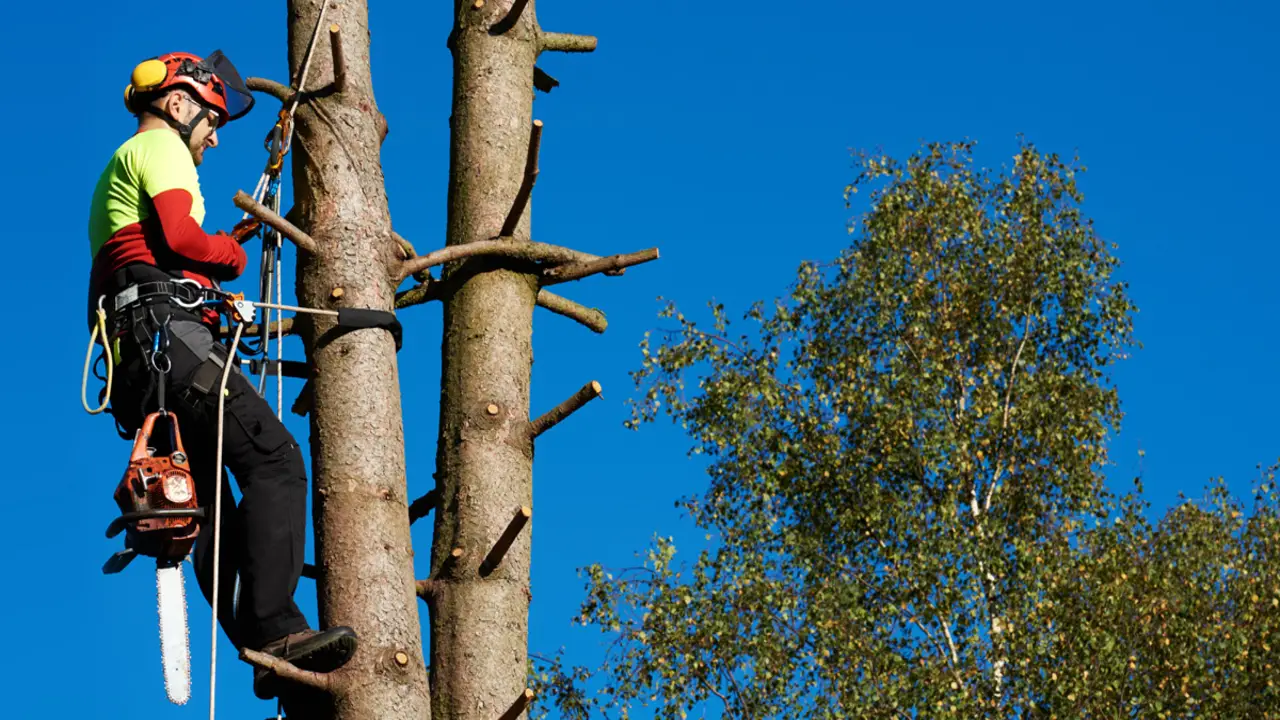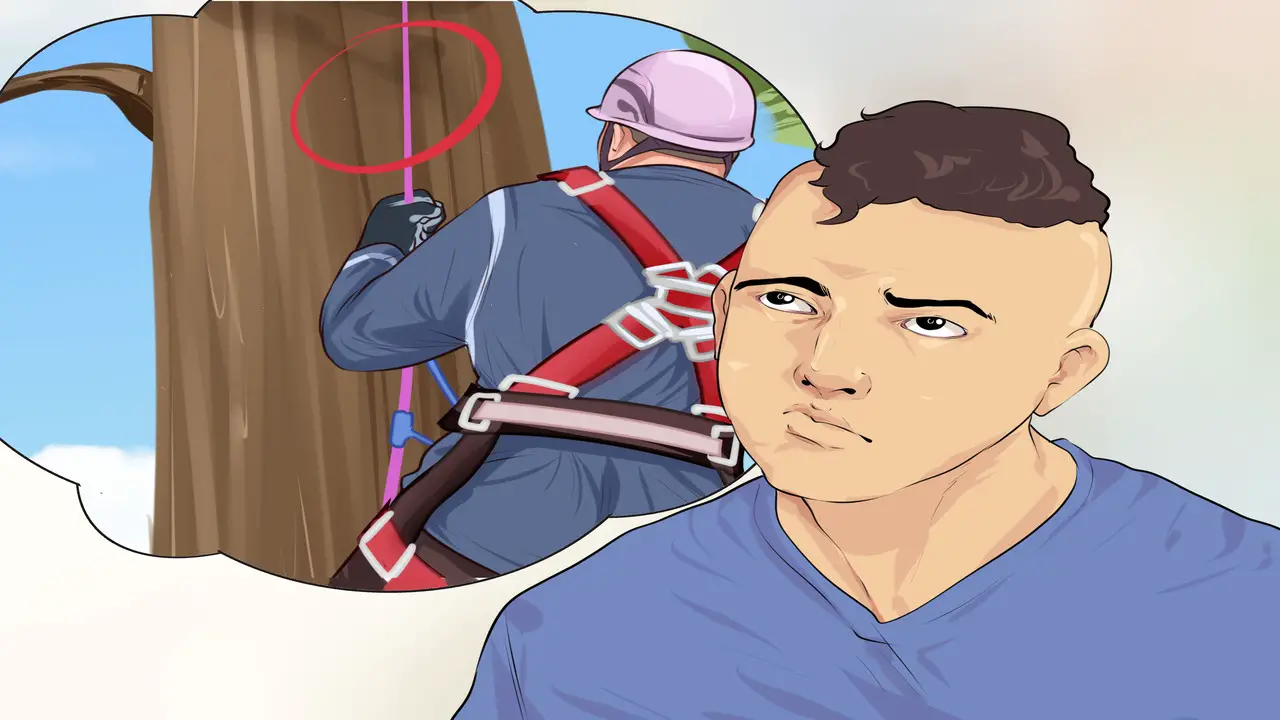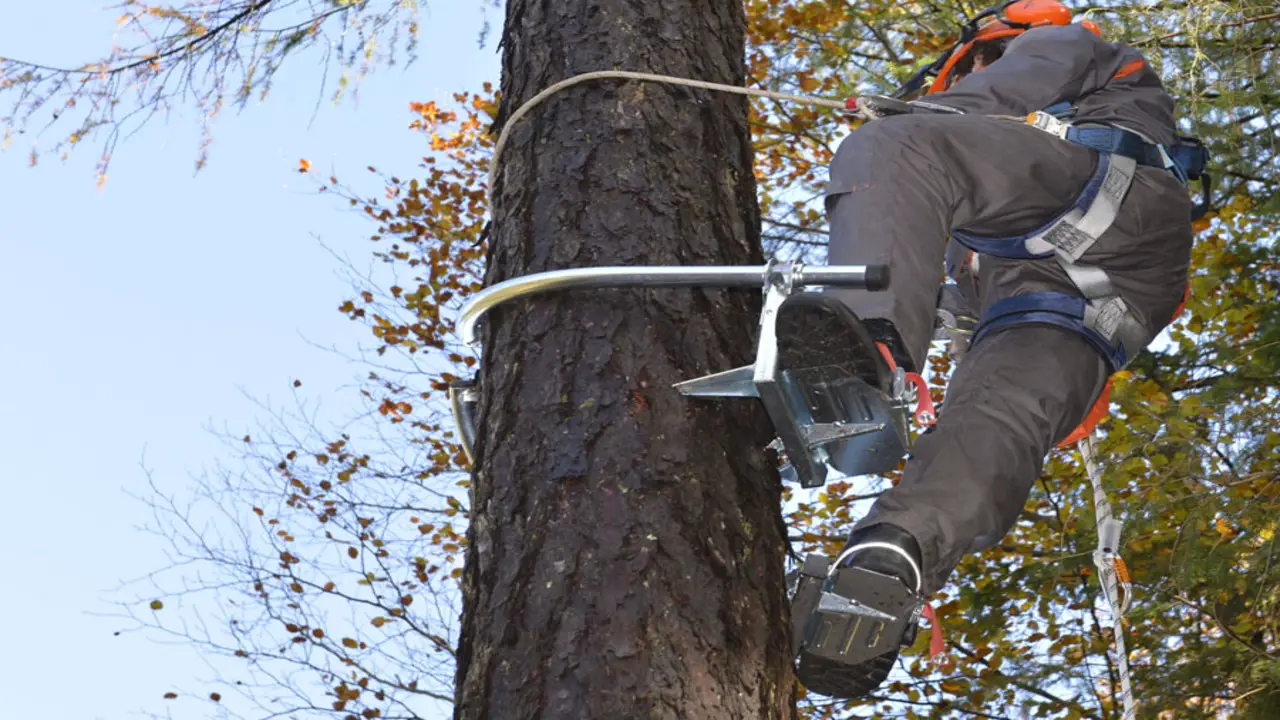Tree climbing with spikes, also known as “spike climbing” or “spur climbing”, is popular among outdoor enthusiasts and arborists. It involves ascending a tree using specialized equipment and techniques and can be a thrilling and rewarding experience.
However, for beginners, climbing a tree with sharp metal spikes attached to their feet may seem daunting and even dangerous. This is why we have put together a comprehensive guide for beginners on how do beginners climb trees with spikes?
We will cover everything from the necessary equipment and proper techniques to safety precautions and tips for success. So whether you are a nature enthusiast looking for a new adventure or considering pursuing a career as an arborist, this beginner’s guide will provide all the information you need to get started in the exciting world of tree climbing with spikes.

What Are Tree-Climbing Spikes?

Tree-climbing spikes, also known as tree spurs or gaffs, are specialized tools arborists and experienced tree climbers use to assist in ascending trees. They consist of a metal shank with sharp spikes or hooks at the end that can be strapped to the climber’s legs.
These spikes are designed to penetrate the bark of the tree and provide traction, allowing the climber to climb upward. It is important to note that trained professionals should only use tree-climbing spikes, as improper use can cause damage to trees and pose safety risks. Beginners should always receive proper training and guidance before using tree-climbing spikes.
Importance Of A Harness In Tree Climbing

Regarding tree climbing, having the right equipment is crucial for safety. One important piece of equipment that beginners should always use is a harness. A harness provides support and stability while climbing, allowing climbers to free both hands to grip the tree and manoeuvre themselves.
Additionally, a harness helps distribute the weight evenly across the body, reducing strain on any one area. This can help prevent fatigue and discomfort during long climbs. Choosing a harness that fits properly and is designed specifically for tree climbing is important to ensure maximum safety and comfort. So, before you embark on your tree-climbing adventure, don’t forget to strap on that harness – your safety depends on it!
How Do Beginners Climb Trees With Spikes? 6 Easy Ways

Climbing trees with spikes can be a challenging task, especially for beginners. However, it can be made easier and safer with the right technique and equipment. Remember, tree climbing with spikes should always be cautiously approached, and it’s important to prioritize safety at all times. Here we know you how do beginners climb trees with spikes?
1.Preparing The Right Equipment

Regarding climbing trees with spikes, beginners should make sure they have the right equipment. Here are some key items to consider:
Climbing spikes: These are the most important equipment for tree climbing. Make sure you choose spikes suitable for your weight and the type of tree you will be climbing.
Climbing harness: A harness is essential for safety and support while climbing. Look for a comfortable and adjustable harness that fits securely.
Climbing rope: A strong and durable rope is necessary for ascending and descending the tree. Choose a rope that is long enough for your desired height and has a high weight capacity.
Carabiners: Carabiners attach the rope to your harness and other equipment. Opt for reliable and sturdy carabiners that can withstand the weight and pressure of climbing.
Helmet: Protecting your head is crucial, so invest in a quality helmet designed specifically for tree climbing. Look for one that is adjustable and provides adequate ventilation.
By ensuring you have the right equipment, you can climb trees with spikes safely and enjoyably as a beginner. Always prioritize safety and follow proper techniques when ascending and descending trees.
2.Understanding The Basics Of Spikes

For beginners looking to climb trees with spikes, it is important to understand the basics of using them. Spikes, or climbing spurs or gaffs, are metal protrusions that attach to the legs and allow climbers to grip the tree trunk. Before attempting to climb with spikes, it is crucial to have proper training and understand the potential risks involved.
Climbers should also ensure they have the necessary safety equipment, such as a helmet and harness, and follow recommended safety guidelines. Additionally, it is important to consider the impact of spiking on trees and only climb when necessary and responsibly to minimize harm to the tree. By understanding the basics of using spikes and practising safe climbing techniques, beginners can safely enjoy the experience of tree climbing.
3.Choosing The Right Tree
Regarding climbing trees with spikes, choosing the right tree is crucial for the safety and health. It’s important to select a healthy, sturdy tree that is capable of supporting your weight. Look for trees with strong branches at least 6 inches in diameter.
Avoid trees that have signs of decay, such as dead or rotting branches, as they may not be able to withstand the pressure exerted by the climbing spikes. Additionally, consider the species of the tree and its growth patterns. Some trees, like conifers, have branches that are close together and can provide more stability for climbing. You can ensure a safer and more enjoyable climbing experience by carefully selecting the right tree.
4.Securing The Spikes

Setting the spikes into the tree trunk requires careful attention to the angle for effective climbing. Firmly planting and securing the spikes before ascending is crucial to ensure safety. Double-check the tightness of the straps and buckles to provide maximum support.
Adjust the height of the spikes according to your leg length for comfortable climbing. Regularly inspect the spikes for signs of damage or wear to maintain their integrity. By following these guidelines, beginners can securely climb trees with spikes.
5.Climbing Up And Down Safely

Safety is of utmost importance for climbing trees with spikes, especially for beginners. Here are some tips to help you climb up and down safely:
- Use the right gear: Invest in a good pair of tree climbing spikes or spurs that fit you properly and provide a secure grip on the tree trunk. Wear a sturdy helmet, harness, and gloves for added protection.
- Assess the tree: Before climbing, carefully inspect the tree for any signs of damage or weakness. Look for suitable branches for handholds and footholds while ascending and descending.
- Plan your route: Determine the best path to take up and down the tree, considering the branches’ strength and proximity. It’s essential to have multiple contact points to ensure stability.
- Take it slow: Climbing with spikes requires patience and control. Ascend one step at a time by pushing your weight evenly onto each spur before moving the other foot up. Descend controlled, using your legs to support your weight while slowly lowering yourself.
- Maintain three points of contact: Always have three points of contact with the tree (e.g., two feet and one hand or two hands and one foot) to ensure stability and prevent falls.
- Be mindful of your surroundings: Watch for obstacles or hazards around you while climbing, such as loose branches or power lines. Stay clear of any potential dangers.
- Practice proper technique: Learn proper climbing techniques from experienced climbers or seek professional guidance. This will help you develop efficient movement patterns and reduce strain on your body.
Remember, climbing trees with spikes can be dangerous if not done correctly or without appropriate training.
6.Climbing Gear Essentials For Beginners

When climbing trees with spikes, beginners need to ensure they have the right gear for a safe and successful climb. Here are some essential climbing gear items that beginners should consider:
Tree climbing spikes or spurs are the most important equipment for climbing trees with spikes. They are attached to your boots and allow you to grip onto the tree trunk as you ascend.
Climbing harness: A climbing harness is essential for securing yourself to the tree and preventing falls. It should fit snugly and be comfortable enough for extended periods of wear.
Helmet: A helmet protects your head from potential falling debris or accidental impacts while climbing.
Gloves: Sturdy gloves protect your hands from abrasions and provide a better grip on the tree trunk.
Rope and carabiners: These are necessary to set up a secure anchor point and attach yourself to the tree while climbing.
It is important to note that climbing trees with spikes should only be done by experienced climbers or under the guidance of a professional. Safety should always be the top priority when engaging in any type of tree-climbing activity.
Safety Tips For Beginners

Regarding climbing trees with spikes, safety should always be the top priority. Here are some important tips for beginners to ensure a safe and enjoyable climbing experience:
- Invest in proper gear: Wear a helmet, harness, and sturdy boots for tree climbing. These will provide protection and support while ascending and descending.
- Learn proper technique: Before attempting to climb a tree with spikes, take the time to learn proper climbing techniques from experienced climbers or through instructional videos. This will help you understand how to use the spikes effectively and minimize the risk of accidents.
- Choose the right tree: Not all trees are suitable for climbing with spikes. Look for healthy trees with strong branches that can support your weight. Avoid trees with decay or weak limbs that could break during the climb.
- Inspect your equipment: Before each climb, thoroughly inspect your gear for any signs of damage or wear. Check the spikes, straps, and buckles to ensure they are secure and in good condition.
- Start with low heights: If you’re new to tree climbing, start with shorter trees to practice your technique and build confidence before attempting higher climbs.
- Be aware of hazards: Watch for power lines, dead branches, or wasp nests while climbing. Stay clear of these dangers to avoid accidents.
- Have a spotter: Having someone on the ground who can watch you while you climb is always a good idea. They can offer guidance, assist if needed, and call for help in an emergency.
Remember, tree climbing with spikes can be dangerous if not done properly. Take your time, follow safety guidelines, and never push yourself beyond
Maintaining The Spikes For Future Use
Maintaining the spikes on tree-climbing gear is essential for future use. Beginners just starting to climb trees with spikes should pay close attention to the maintenance and care of their equipment. After each use, cleaning and inspect the spikes for any signs of damage or wear is important.
If there are any issues, such as bent or dull spikes, they should be replaced immediately to ensure safe and effective climbing in the future. Additionally, storing the spikes in a cool and dry place will help prevent rust or corrosion, which can compromise their performance. By taking these steps to maintain the spikes on tree-climbing gear, beginners can ensure that their equipment remains in optimal condition for future climbs.
Conclusion
Simply climbing trees with spikes requires proper knowledge, equipment, and safety measures. Beginners should always prioritize safety by using a harness, wearing appropriate climbing gear, and following safety tips. It is important to prepare the right equipment, understand the basics of spikes, choose the right tree, secure the spikes properly, and climb up and down safely.
Regular maintenance of the spikes is also crucial for future use. Remember, tree climbing can be a thrilling and rewarding experience, but it should always be done responsibly and with caution. So, if you’re a beginner interested in tree climbing, follow these easy steps how do beginners climb trees with spikes?
Frequently Asked Questions
[rank_math_rich_snippet id=”s-53eee080-1c27-4d7a-8bed-f59a0ae7f170″]

I am passionate about home engineering. I specialize in designing, installing, and maintaining heating, ventilation, and air conditioning systems. My goal is to help people stay comfortable in their homes all year long.
